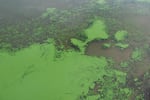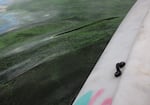
Dr. Jennifer L. Graham / USGS
Last month, the Oregon Health Authority released a health advisory for the Ross Island Lagoon in the Willamette River, due to an algae bloom that has produced low but detectible levels of toxins.
OPB spoke with two experts to clear up our questions about the bloom: Aaron Borisenko, the water quality monitoring manager at the Oregon Department of Environmental Quality, and Rebecca Hillwig, an environmental health specialist with the state's harmful algae bloom surveillance program. Here's what we learned:
1. The bloom is made up of photosynthetic bacteria, not algae.
The tiny globes of green scum visible on the surface of the Willamette are cyanobacteria. While people often refer to cyanobacteria as blue-green algae, they have little in common with seaweed or the stringy green algae species that grow on lake bottoms, and are more accurately classified as a photosynthetic bacteria.
Cyanobacteria are among the oldest living organisms on the planet, and having some in the Willamette River is natural and even healthy. "We don't want to eradicate them. They are the No. 1 oxygen producer on the planet, a good organism that gets a bad rap," said Hillwig.
But warm temperatures and low flow in the river have allowed the cyanobacteria to multiply, to a point where they can pose a risk to human health. Each tiny green ball visible to the naked eye is a colony made up of millions of individual cyanobacteria organisms. Hiillwig and Borisenko said testing last year found 2 million cyanobacteria cells in about 50 milliliters of river water, and the bloom visible this summer consists of many billions of organisms.
2. Cyanobacteria has been spotted from Ross Island to Cathedral Park.
While the health advisory just covers the most prevalent bloom in the Ross Island Lagoon, the Department of Environmental Quality has seen signs of cyanobacteria in the river as far downstream as St. John's and Cathedral Park.
And the absence of a green sheen on the surface of the water doesn't necessarily mean that a reach of the river is free from bacteria. "They can change their buoyancy in the water column, so sometimes they'll be at the surface of the water. Other times of day, they can be down deeper and you may not see them," said Borisenko.
The colonies tend to rise to the surface to capture sunlight for photosynthesis and to produce food, and then sink down in the water column when they are "full."

Cyanobacteria colonies near the Swan Island basin in the Willamette.
Amelia Templeton / OPB
3. It's probably safe to swim for now, but you should be careful.
Testing done by the DEQ has detected some toxins from the bloom, including microcystin, which is a liver toxin. "But at this point in time, it's at very low levels, well under the guidelines we have for human exposure," said Hillwig. "Our data suggests that it is still safe to swim in the water," added Borisenko.
People do not absorb microcystin through their skin, which also reduces the risk to swimmers. However, ingesting the water as you're swimming can be harmful. The symptoms of microcystin exposure are similar to food poisoning: vomiting, diarrhea, and occasionally fever and chills.
"A lot of times, those symptoms go unreported to us, because people associate them with something other than exposure to a bloom," Hillwig said.
The DEQ is collecting water samples and testing for toxins on a weekly basis, so check for new advisories before getting in the water.
4. Keep dogs away from the bloom
Dogs are particularly susceptible to the effect of microcystin. "For people, with this particular toxin, our exposure level is 10 parts per billion," said Hillwig. "For dogs, for this particular toxin, it's .2 parts per billion."
Dogs are also more likely to be exposed, because they tend to drink river water and lick it off their fur. As a result, blooms that might not trigger a human health advisory can actually be lethal to dogs. "We are always recommending that people keep their dogs away from any water that may be affected by a bloom," Hillwig said.
If you suspect your dog has been exposed, take it to a vet immediately.
5. You can help
While the primary catalyst for the cyanobacteria explosion in the Willamette is warm temperatures and low water flow — this summer is the hottest on record in Oregon — there are some things you can do, in addition to limiting your carbon emissions, to help respond to blooms.
Phosphorus and nitrogen, which are present in many fertilizers and lawn products, can help cyanobacteria grow. Limiting the use of phosphorus and nitrogen products in your garden can help limit the growth of cyanobacteria in nearby waterways, according to Borisenko.
Finally, if you suspect you or a pet have developed symptoms after exposure to an algae bloom, contact the Harmful Algae Bloom Surveillance Program. The staff there can help you determine whether exposure to cyanobacteria caused the symptoms, and can warn other people to avoid the area.